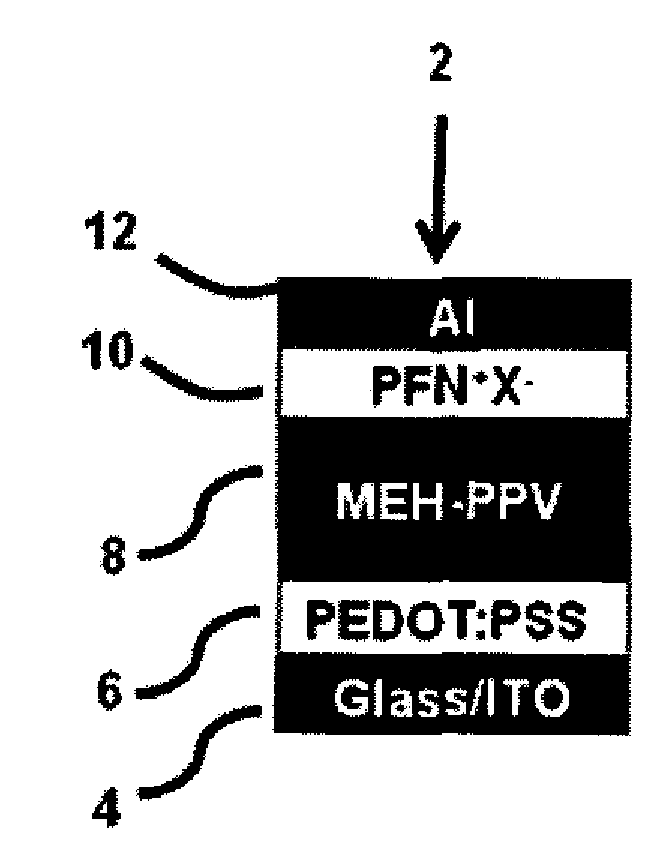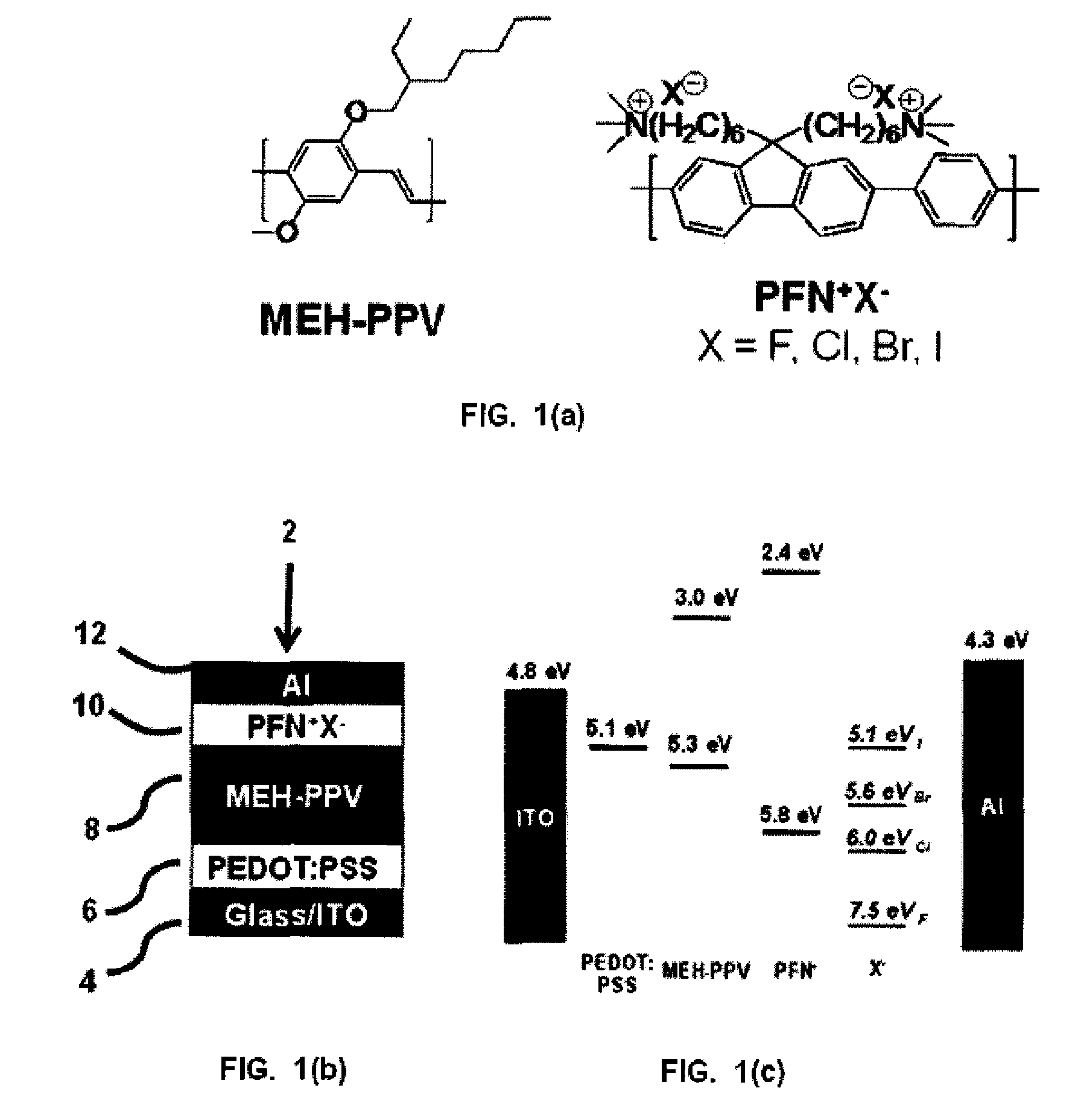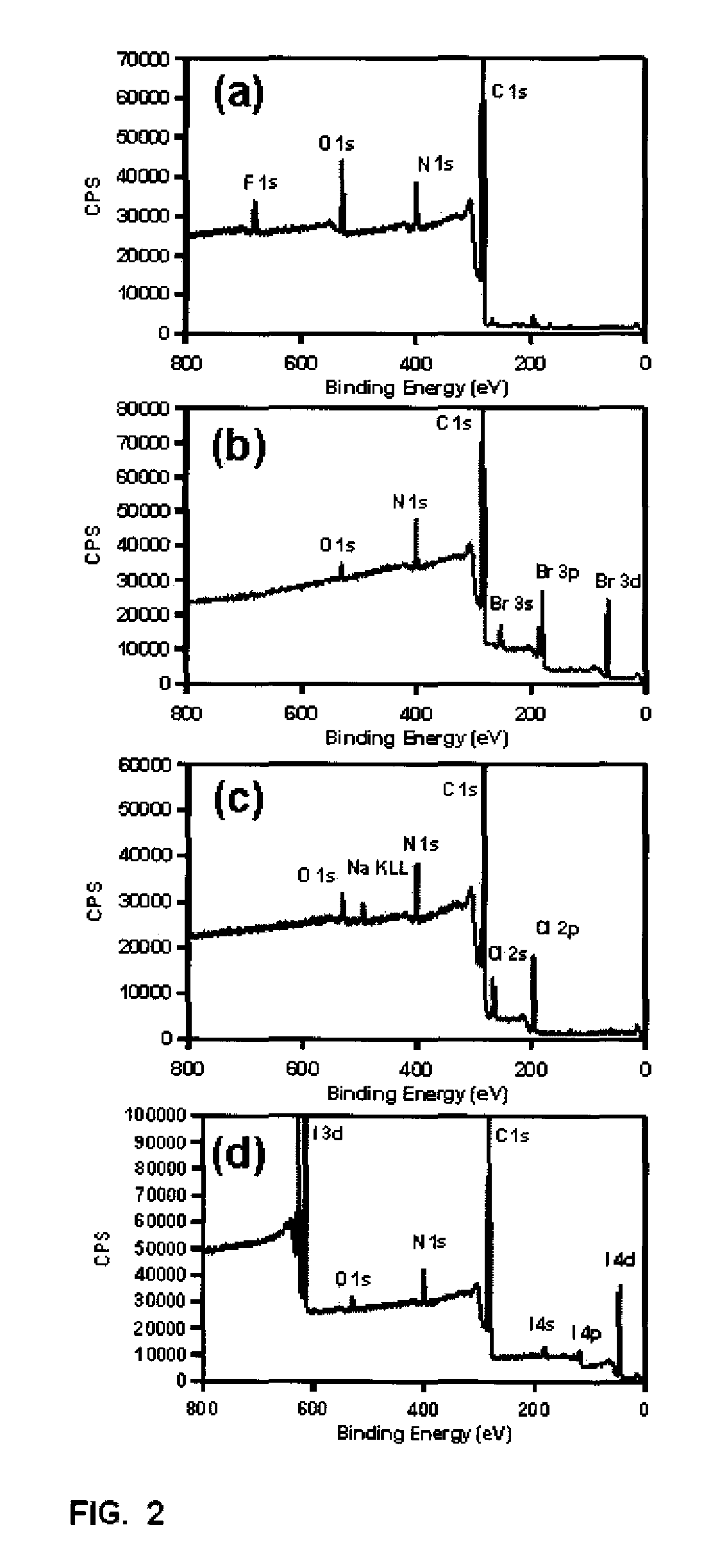Cationic conjugated polyelectrolyte electron injection layers altered with counter anions having oxidative properties
a technology of conjugated polyelectrolyte and electron injection layer, which is applied in the direction of organic semiconductor devices, solid-state devices, thermoelectric devices, etc., can solve the problems of order of magnitude differences in device performance, and achieve the effect of increasing the performance of multi-layer polymer light-emitting diodes
- Summary
- Abstract
- Description
- Claims
- Application Information
AI Technical Summary
Benefits of technology
Problems solved by technology
Method used
Image
Examples
example 1
Methods and Materials
[0032]MEH-PPV (14) and PFN+Br− (15) were synthesized according to previous reports. PFN+F−, PFN+Cl− and PFN+1− were acquired from PEN+Br− ion exchange with dialysis membranes and mixing with the appropriate potassium salt. Cellulose ester dialysis membranes (Spectrum Laboratories, Inc.) with a 1,000 molecular weight cut off were filled with a water solution of PFN+Br− followed by addition of excess amount (5:1 weight) of the appropriate potassium halide salt. The dialysis membrane were immersed in a stirred de-ionized water bath until the osmotic pressure was reduced (˜4 days) when upon more salts were added. This was repeated three times followed by evaporation of water under reduce pressure. Counter ion exchange was confirmed with X-ray photoelectron spectroscopy (XPS) measurements of the powdered CPE samples with a Kratos Axis Ultra XPS system with a base pressure of 1×10−10 mbar (UHV), using a monochromated Al Kα X-ray source at hv=1486 eV. The structures of...
example 2
Materials Characterization
[0036]Devices prepared as in Example 1 were characterized.
[0037]Spectra of XPS measurements of CPE powder samples are shown in FIG. 2 for PFN+F− (a), PFN+Cl− (b), PFN+Br− (c) and PFN+I− (d) samples. All spectra exhibited the corresponding halide anion signals with no evidence of any potassium signals indicating the removal of the excess salt added in the anion exchange procedure. The degree of anion exchange was determine to be greater than 97% in all samples by comparison to bromide signals, indicating successful anion exchange.
[0038]The absorption and PL spectra of CPEs films are shown in FIG. 3. The absorption and PL spectra of all the CPEs are similar with insignificant changes in band width and absorption (˜378 nm) and PL (˜428 nm) maxima. The PL spectra exhibit vibronic progression and no additional broad bands at longer wavelengths, indicating lack of π-π aggregates commonly observed in CPEs films due to processing in polar medium (16-20). The spectr...
example 3
Conclusions
[0047]In summary, a systematic investigation of the influence of the halide counter anion of CPE EILs on multilayer PLED device performance is presented. A general trend in device performance is observed with CPEs EILs containing halide counter anions (PFN+F−>PFN+Cl−>PFN+Br−>PFN+I−), which was determined to not correlate with difference in electron mobilities of the CPE, as has been observed in other CPE systems (9). Although not wishing to be bound by this idea, the device efficiency is believed to be influenced by the relative oxidation potential of the counter anion via oxidation by accumulated holes in the MEH-PPV / CPE interface. Measurements of the effects of reduced ion motion in PLED devices accomplished with pulse bias measurements results in a decrease in device efficiency with the relative more electrochemical stable PEN+F− system while and an increase in device efficiency with relatively less electrochemically stable PFN+Br− system. This correlates well with the...
PUM
 Login to View More
Login to View More Abstract
Description
Claims
Application Information
 Login to View More
Login to View More - R&D
- Intellectual Property
- Life Sciences
- Materials
- Tech Scout
- Unparalleled Data Quality
- Higher Quality Content
- 60% Fewer Hallucinations
Browse by: Latest US Patents, China's latest patents, Technical Efficacy Thesaurus, Application Domain, Technology Topic, Popular Technical Reports.
© 2025 PatSnap. All rights reserved.Legal|Privacy policy|Modern Slavery Act Transparency Statement|Sitemap|About US| Contact US: help@patsnap.com



